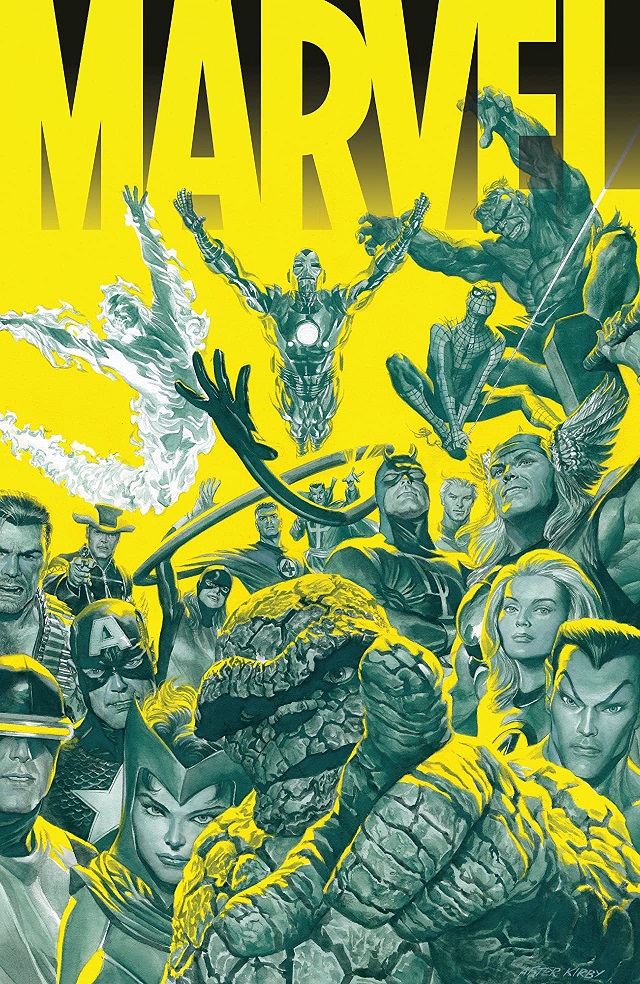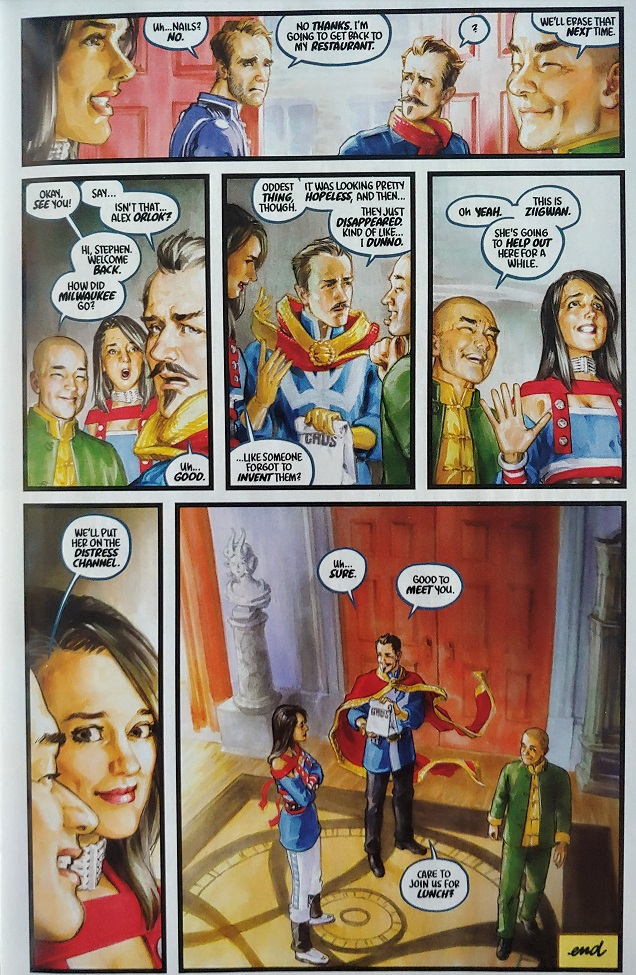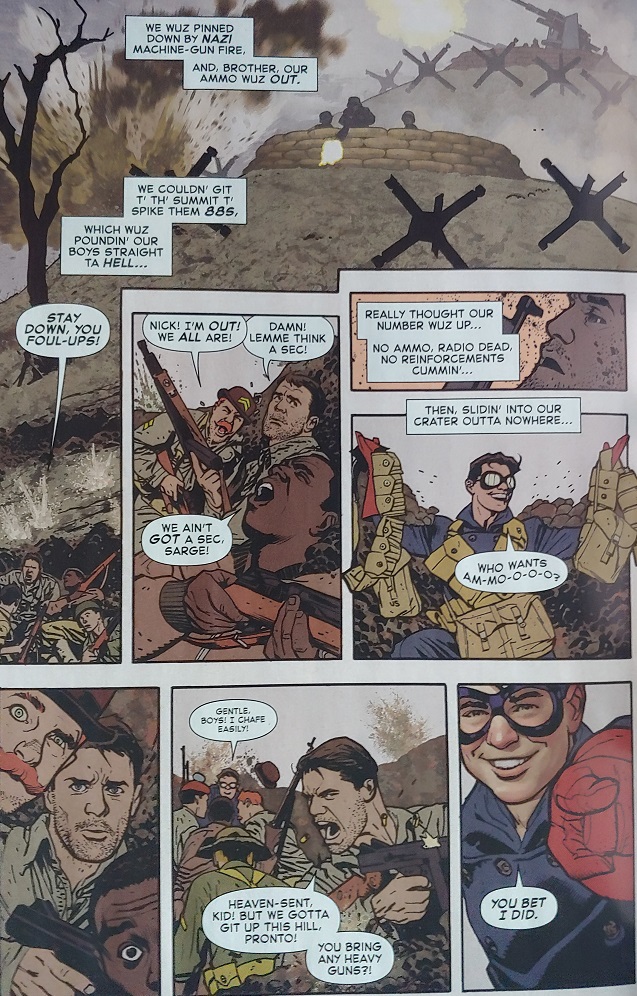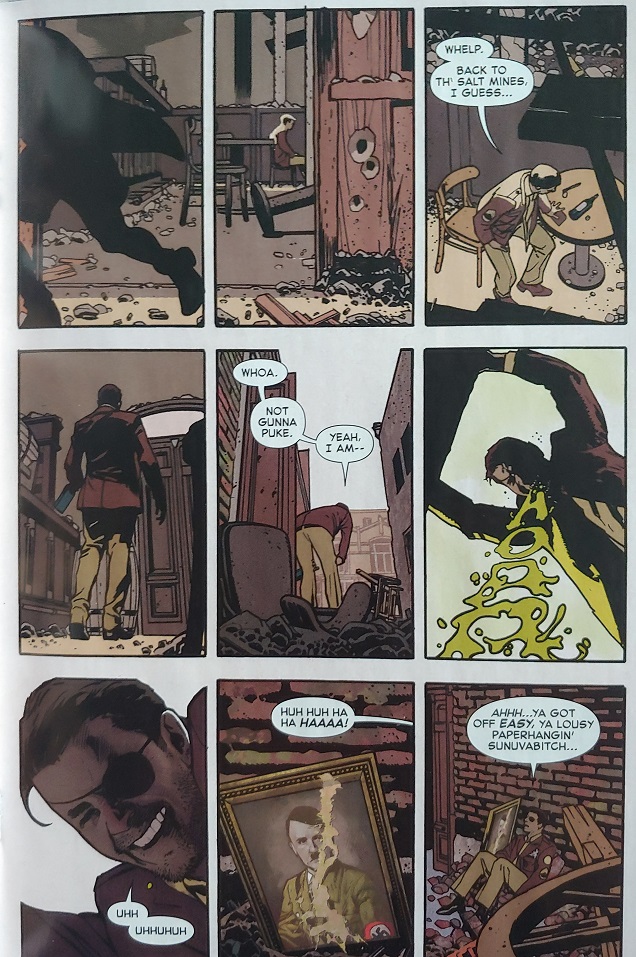It has taken me almost 2 years to finish reviewing the 6-issue miniseries aptly titled Marvel. Following an anthological format rarely seen these days in the Big Two, Marvel turned out to be a magnificent confluence of outstanding creators. Of course, to provide cohesiveness to the project, Alex Ross was in charge of all the covers plus the main story, the only one that continues from one issue to the next. In the 6th and last chapter, Alex Ross comes up with a striking cover that reunites the most important Marvel characters from the early 60s, and unlike other colorful covers, these one has only two tones that go really well together, a primary yellow and a green hue.
As usual, the “Overture” is the work of Alex Ross and Steve Darnall; once again, the cosmic confrontation between Doctor Strange and Nightmare is reaching its final stages. Now it’s time to either give up or muster the necessary strength to defeat Nightmare. In the conclusion of the story, we see many Marvel superheroes on the page, although this time instead of the magnificent and photorealistic art from Ross, what we see is the more cartoonish and simple lines of Mitch O’Connell.
 |
| Alex Ross |
The next story is “The One-Eyed Gambit”, written, illustrated and colored by Greg Smallwood. Here we get to see Nick Fury fighting against Advanced Idea Mechanics (A.I.M.) and most specifically against MODOK (Mental Organism Designed Only for Killing). I really enjoyed the combination of pop art sensibility with 60s nostalgia in this charming story that rescues the most essential aspect of Nick Fury, id est, his super spy facet. There are of course some clever references to James Bond, including casinos, high stakes gambling and deformed villains, it all works together marvelously.
I have to say that before last year I simply had no idea who Greg Smallwood was, but I certainly enjoyed this short story and recently I have been very pleased with his artistic contributions to Tom King’s The Human Target (which I should be reviewing soon). Evidently, Smallwood has a unique style and he’s not afraid of delving into nostalgia or previous decades to find visually appealing aesthetics. Also, the fact that he pencils, inks and colors all of his works is admirable.
 |
| Greg Smallwood |
And at last but not least we have a very special story written and fully illustrated by Lee Bermejo. “The Silver Glint of Space” is also the only black and white story in the anthology, but Bermejo’s art is so detailed and visually striking, that color actually isn’t needed. In recent years Bermejo has become one of my favorite artists, and that is the reason why I’ve been buying as many of his comics as possible, even if sometimes I don’t like the writers he’s teamed up with.
 |
| Greg Smallwood |
“The Silver Glint of Space” is a post-apocalyptic story in which our planet is in ruins and the only living man is Johnny Storm, the Human Torch. He’s the only one present and it’s his duty to talk to the Silver Surfer, the herald of Galactus. It’s a bitter conversation but quite a revealing one. Bermejo proves to be not only an amazing artist but also a very competent writer. John Byrne was the first author to ever write a post-apocalyptic story in the X-Men with “Days of Future Past” and in Fantastic Four with “The Last Galactus Story”, in which Galactus’ herald visits a devastated Earth. In “The Silver Glint of Space” Galactus’ herald finds our world destroyed but at least he’s able to have a meaningful conversation with Johnny Storm. I wish we could see more projects like this, Marvel certainly was a marvelous anthology!
________________________________________________________________________________________________________
________________________________________________________________________________________________________
Me he demorado casi 2 años en terminar de reseñar la miniserie de 6 números acertadamente titulada Marvel. Siguiendo un formato antológico pocas veces visto estos días en las grandes editoriales, Marvel resultó ser una magnífica confluencia de destacados creadores. Por supuesto, para darle cohesión al proyecto, Alex Ross estuvo a cargo de todas las portadas más la historia principal, la única que continúa de un número a otro. En el sexto y último capítulo, Alex Ross presenta una llamativa portada que reúne a los personajes más importantes de Marvel de principios de los 60s, y a diferencia de otras coloridas portadas, esta tiene solo dos tonos que combinan muy bien, un amarillo primario y un tono verde
 |
| Lee Bermejo |
Como es habitual, la “Obertura” es obra de Alex Ross y Steve Darnall; una vez más, la confrontación cósmica entre Doctor Strange y Nightmare está llegando a sus etapas finales. Ahora es el momento de rendirse o reunir la fuerza necesaria para derrotar a Nightmare. En la conclusión de la historia, vemos muchos superhéroes de Marvel en la página, aunque esta vez en lugar del magnífico y fotorrealista arte de Ross, lo que vemos son las líneas más caricaturescas y simplonas de Mitch O'Connell.
 |
| Lee Bermejo |
La siguiente historia es “El gambito tuerto”, escrita, ilustrada y coloreada por Greg Smallwood. Aquí podemos ver a Nick Fury luchando contra Mecánica de Ideas Avanzadas (o A.I.M. por sus siglas en inglés) y más específicamente contra MODOK (Organismo Mental Diseñado Sólo para Matar por sus siglas en inglés). Disfruté mucho la combinación de la sensibilidad del arte pop con la nostalgia de los 60s en esta encantadora historia que rescata lo más esencial de Nick Fury, es decir, su faceta de súper espía. Por supuesto, hay algunas referencias ingeniosas a James Bond, incluidos los casinos, los juegos de azar de alto riesgo y los villanos deformes, todo funciona en conjunto maravillosamente.
 |
| Lee Bermejo |
Debo decir que antes del año pasado simplemente no tenía idea de quién era Greg Smallwood, pero ciertamente disfruté de esta historia corta y recientemente estoy muy complacido con sus contribuciones artísticas a The Human Target de Tom King (que debería reseñar pronto) . Evidentemente, Smallwood tiene un estilo único y no teme adentrarse en la nostalgia o en décadas anteriores para encontrar una estética visualmente atractiva. Además, el hecho de que dibuja, entinta y colorea todos sus trabajos es admirable.
 |
| Mitch O'Connell |
Y por último, pero no menos importante, tenemos una historia muy especial escrita y totalmente ilustrada por Lee Bermejo. “El destello de plata del espacio” también es la única historia en blanco y negro de la antología, pero el arte de Bermejo es tan detallado y visualmente impactante que el color en realidad no es necesario. En los últimos años Bermejo se ha convertido en uno de mis artistas favoritos, y esa es la razón por la que he estado comprando la mayor cantidad posible de sus cómics, aunque a veces no me gustan los escritores con los que se asocia.
“El destello de plata del espacio” es una historia post-apocalíptica en la que nuestro planeta está en ruinas y el único hombre vivo es Johnny Storm, la Antorcha Humana. Él es el único presente y es su deber hablar con Silver Surfer, el heraldo de Galactus. Es una conversación amarga pero bastante reveladora. Bermejo demuestra ser no sólo un artista asomobroso sino también un escritor muy competente. John Byrne fue el primer autor en escribir una historia post-apocalíptica en los X-Men con “Días del futuro pasado” y en Fantastic Four con "The Last Galactus Story", en la que el heraldo de Galactus visita una Tierra devastada. En “El destello de plata del espacio”, el heraldo de Galactus encuentra nuestro mundo destruido, pero al menos puede tener una conversación significativa con Johnny Storm. Ojalá pudiéramos ver más proyectos como este, ¡Marvel ciertamente fue una antología maravillosa!































